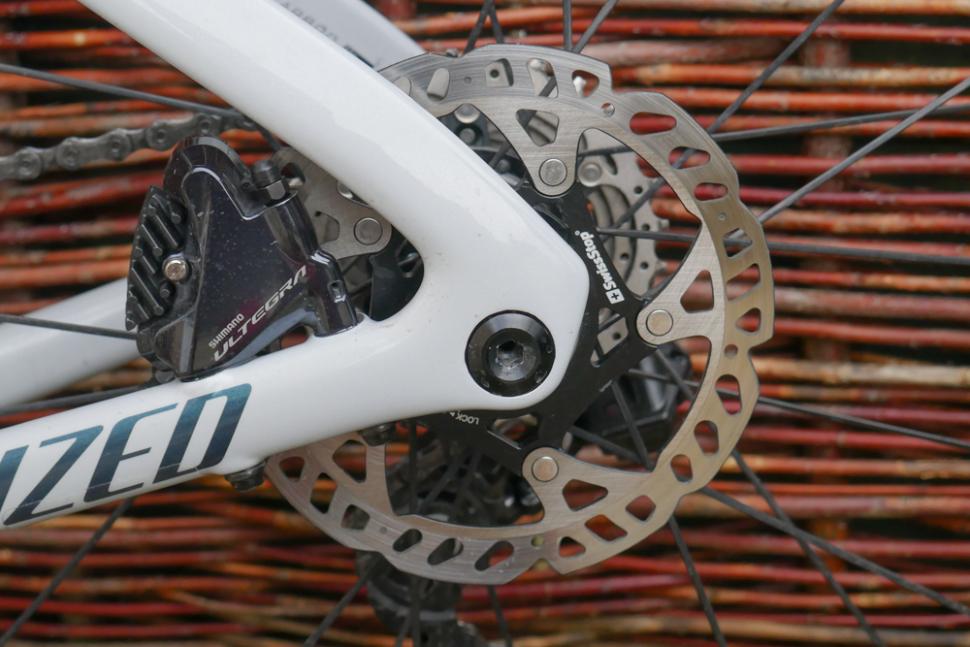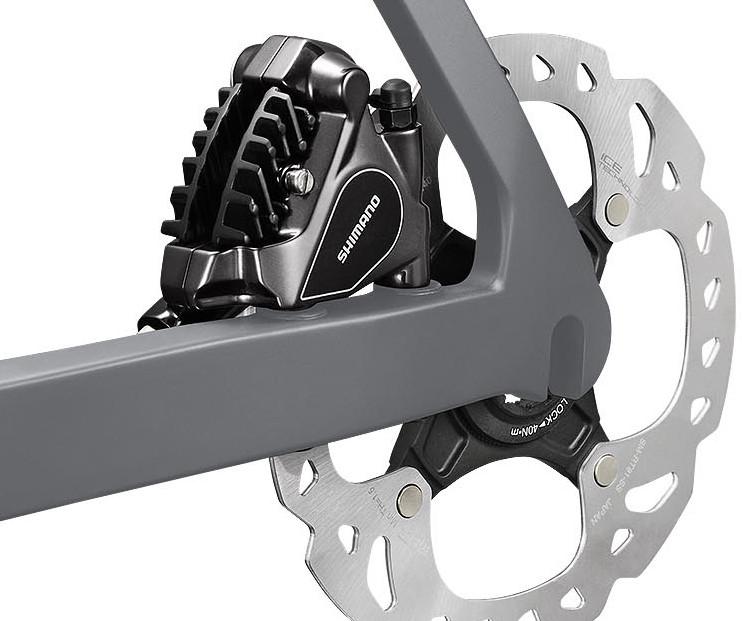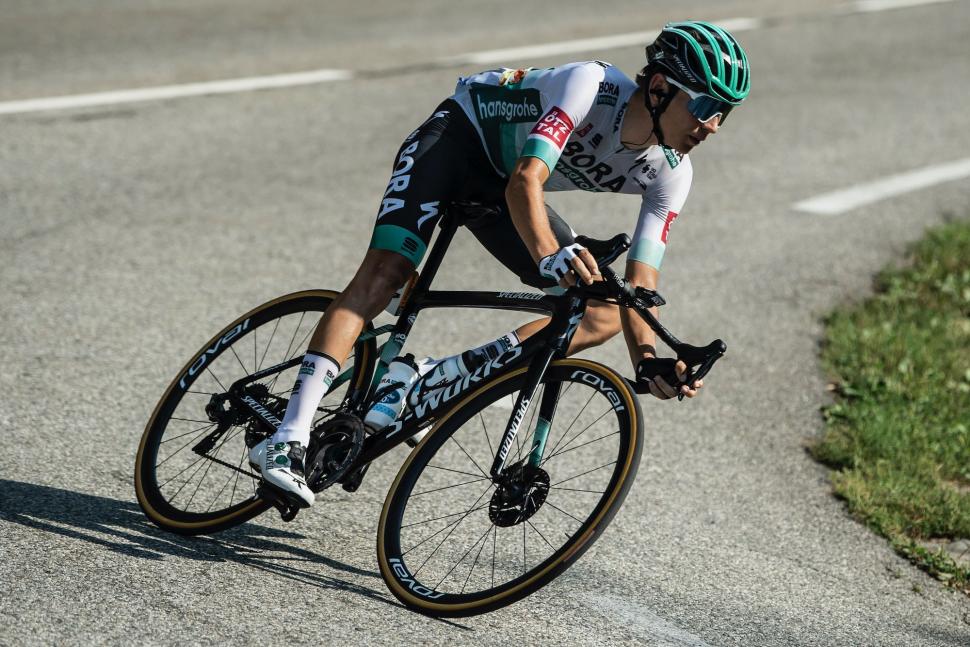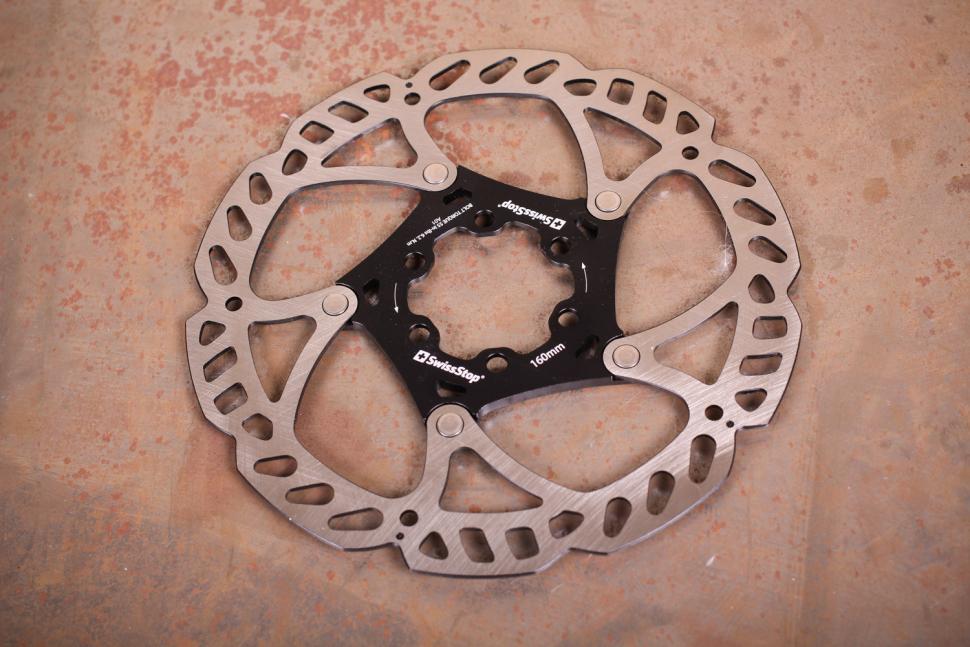- News
- Reviews
- Bikes
- Components
- Bar tape & grips
- Bottom brackets
- Brake & gear cables
- Brake & STI levers
- Brake pads & spares
- Brakes
- Cassettes & freewheels
- Chains
- Chainsets & chainrings
- Derailleurs - front
- Derailleurs - rear
- Forks
- Gear levers & shifters
- Groupsets
- Handlebars & extensions
- Headsets
- Hubs
- Inner tubes
- Pedals
- Quick releases & skewers
- Saddles
- Seatposts
- Stems
- Wheels
- Tyres
- Tubeless valves
- Accessories
- Accessories - misc
- Computer mounts
- Bags
- Bar ends
- Bike bags & cases
- Bottle cages
- Bottles
- Cameras
- Car racks
- Child seats
- Computers
- Glasses
- GPS units
- Helmets
- Lights - front
- Lights - rear
- Lights - sets
- Locks
- Mirrors
- Mudguards
- Racks
- Pumps & CO2 inflators
- Puncture kits
- Reflectives
- Smart watches
- Stands and racks
- Trailers
- Clothing
- Health, fitness and nutrition
- Tools and workshop
- Miscellaneous
- Buyers Guides
- Features
- Forum
- Recommends
- Podcast
feature
 SwissStop Catalyst Rotors 140mm
SwissStop Catalyst Rotors 140mmWhat’s wrong with Chris Froome’s disc brakes?
Chris Froome moved from the Ineos Grenadiers (formerly Team Sky) to Israel Start-Up Nation for the 2021 season, and he’s done more than change his jersey. Froome has also switched from Pinarello to Factor bikes, a move that will see him racing on disc brakes for the first time in his career.
But in a video where he tried his hand at reviewing his new Factor Ostro VAM, Froome wasn’t singing the praises of disc brakes. Despite saying that the performance in both wet and dry conditions impressed him, he didn’t feel the same way about all aspects of his new components. It's a very honest review of the bike which is certainly refreshing from a pro rider, most of whom usually repeat the lines that the marketing department has given them.
> 8 reasons not to get disc brakes — find out the hassles before you switch
We’ve re-watched Froome's review, paying particular attention to his comments about what he doesn’t like about those disc brakes, and we’ve noted the likely causes, the fixes, and how to avoid the issues in the first place. You can thank us later, Chris. Maybe in your Tour de France winner’s speech.
Froome makes a valid point regarding disc brakes being something that many racers wouldn’t have chosen had the manufacturers not pushed them. Froome says that they “are going to have to adapt and learn to use them, because if you're not on disc brakes already it's only a matter of time before you're made obsolete and forced onto them.”
Froome's points are also common issues that many riders that are new to disc brakes will encounter, so it is certainly useful to explore the tips and tricks that will make the disc-brake user experience better if you too have just switched over.
Before we dive in, we’re not about to bash either rim brakes or disc brakes. Each system has good and bad points and has been used in and out of the racing world just fine for years.
Right then, let’s get into the issues that Froome cited in his video, and see if we can help fix them.
A downside to disc brakes is the constant rubbing
Yep, just like a rim-brake, a disc system will rub if incorrectly set up. If the rubbing is constant and you can hear the noise through the whole rotation of the rotor, the calliper needs repositioning. Check the thru-axle is tight first.
> How to look after disc brakes — 7 ways to get the best performance
If you can hear a noise at only a certain point in the rotation, the rotor is likely bent/warped. Straighten it with a disc brake rotor truing tool.
Potential for mechanicals
What can go wrong with a hydraulic disc brake system out on the road? There are a few things like a loss of braking power caused by a leak in the system, the brake rubbing, or even just noise caused by contamination.
Fixing these problems while out training or on a leisurely ride is a case of riding home with one working brake, attempting to straighten the rotor, or simply putting up with the noise.
> Everything you need to know about disc brakes - read our definitive guide
If you’re a pro in a race, you can switch to your spare £11,000 bike at a quiet moment, but an issue with a rim brake setup would likely have you dropping back to the team car anyway.
We'd say that a snapped brake cable and a loss of pressure in a hydraulic disc brake system are equally rare. To avoid issues with either system, check your brakes regularly and keep on top of cleaning and maintenance.
Overheating
If you drag any brake system – ride with the brakes engaged – you’ll eventually overheat a certain part of that system. On a rim brake bike, you could end up exploding the tyre’s inner tube, melting the tubular glue if you’re on tubs, delaminating the carbon brake track, or something else equally disastrous.
Disc brakes, on the other hand, simply fade (they lose power) – but it takes a very steep hill, a lot of weight and a long time dragging the brakes to do this. The air temperature is also a factor.
On both rim brakes and disc brakes, the answer is simply to avoid dragging your brakes. Actuate them one at a time, allowing each to cool off a bit before you next use it.
The discs become warped
This is a really annoying one. Under really heavy, repeated, or consistent braking, disc rotors can warp, or in simpler terms, go a bit wonky. They need straightening with a proper disc brake rotor truing tool. It might be a good idea to add one to your saddlebag; they’re not heavy.
One piston firing more than the other
This is a dastardly problem that is tricky to spot unless you’ve got the pads out, exposing the pistons.
One piston that moves less than the other can be caused by brake dust that gets deposited on the piston’s rim. If this contamination gets trapped between the calliper and the piston, it can cause friction, stopping the piston from moving freely.
To avoid this, don’t press the pistons back into the calliper if they’re dirty.
> What's the best way to clean disc brakes on a bicycle?
If you have done this, the fix is to clean the brake dust off. You’ll need to expose the piston by actuating the brake lever without the pads in the calliper. Go careful, you don’t want to press the pistons out.
Next, clean the piston rim using cotton buds and something like acetone. Before you press the pistons back into the calliper using a proper piston press, apply a little brake fluid to the piston rim using a clean cotton bud.
You can take this chance to ‘exercise’ each piston individually by actuating the brake while holding the opposite piston back with a plastic tyre lever. Repeat this until both pistons move equally.
Will Froomey be a contender in 2021 if he gets his brakes sorted? Let us know what you think.
Latest Comments
- Destroyer666 4 sec ago
Anodizing the aluminium is also for corrosion resistance and therefore enhances the longevity of the rims while this is not really a case for...
- bobbinogs 1 hour 13 min ago
Wheelsmith has always been very good for me. Malcolm was always very opinionated so I got bored with him telling me I should be riding tubeless,...
- Terry Hutt 1 hour 32 min ago
I assume you can carry an e-bike battery on the tube if you leave the bike at home. ...
- chrisonabike 2 hours 34 min ago
I love it - it's a roundabout with a sculpture of a roundabout on its desk!
- cmedred 2 hours 36 min ago
From the position of the cyclist when the video starts and the position of the bike later, it looks highly unlikely that the cyclist went "into the...
- Rendel Harris 2 hours 42 min ago
To rhyme with design. I wondered this myself so looked it up a while ago, according to the founder Micki Kozuschek he and his team had a few...
- Rendel Harris 3 hours 35 min ago
It's not being pedantic at all, careless driving is successfully prosecuted (and I have been in court more than once when a driver has been...
- HLaB 3 hours 59 min ago
It's hopefully an urban myth but I heard it was designed that way on purpose, so the cyclepath captured any flooding and the busway would remain clear
- mdavidford 4 hours 1 min ago
I should imagine eating chopsticks anywhere could be potentially rather perilous.
- Rendel Harris 4 hours 19 min ago
When The Badger stopped for protesters (albeit dockworkers rather than farmers) it was their stress gauges rather than his that would have been...




Add new comment
84 comments
Which pads are you using?
The originals on the Spyres lasted a year and I'd have bought them again if I could. As it was, I bought whatever was on offer from Chain Reaction which turned out to be EBC which also seem excellent- I can't yet tell if they'll last a year as well!
I've got Shimano organic in the front caliper and EBC in the rear; they just howl at different pitches. I added copper grease to the back of the rear pads and it helped for a while. Might try that again.
they are currently RWD organic,though they seem to be out of stock everywhere at the moment, but the key rather than the brand,though Id never buy purely on price alone, for me was just picking organic compound pads.
the original pads that came with the bike werent very good and I swapped to organic and it fixed alot of the issues Id had with them
my Spyre maintenance regime is I turn a screw every so often when the lever travel feels too long
You missed out the appalling and arduous task of changing the pads once a year after a lot of heavy use on big hills with a heavy trailer. I don't know how I've managed to cope, what with the occasional squeal on first braking in the rain, which then mostly disappears with subsequent braking. I really must go back to all those carefree rainy Lancashire days with all the mud and grit grinding away the rims while braking hardly works!
there arent any big hills in East Anglia I replace front pads maybe once a year, rears last maybe twice as long & its so simple a job, whereas my rim blocks constantly picking out ali pick up from the rim,literally seeing your rim disintegrate in front of your eyes, assuming it hadntly already jammed in the groove wear indicator of the rim, and trashed the blocks on your commute home.
I replace front pads maybe once a year, rears last maybe twice as long & its so simple a job, whereas my rim blocks constantly picking out ali pick up from the rim,literally seeing your rim disintegrate in front of your eyes, assuming it hadntly already jammed in the groove wear indicator of the rim, and trashed the blocks on your commute home.
front pads maybe once a year, rears last maybe twice as long
That's interesting- I ave only a 1 1/4 year experience of discs, but both front and rear wore out at precisely the same time- the indication was a curious clicking noise from both. I couldn't work out the cause but it instantly resolved after quick pad change, and they were all equally worn.
On cable discs that click can be the return spring over-compressing. This can be solved with the pad adjusters on the Spyres. It happened to me on a serious descent - Kenmore Hill, 4 km average 9% and a really steep finish. Glad that the rear brake was still working.
I had been using barrel adjusters on the cables instead of the caliper screws to take up the pad wear, and that's wrong.
Tbf it's just an indicator of my own braking style,in that i bias to the fronts way more than the rears with discs,just because I find it easier to ride like that.
Consequently get very little wear on the rear pad.
Weirdly rim brakes totally different, I grab at both mostly equally,but with more rear bias instead.
I often find I start by applying boith equally, but if going downhill or braking hard I soon have to back off on the rear brake or the rear wheel locks up. Due to the weight and turning moment reactions pushing more weight onto the front wheel. I suppose backing off both brakes might also resolve the rear wheel locking while providing the same deceleration.
Perhaps if riding on the flat and always braking early and gradually wear might be more even. But then arguably rim brakes would be fine. Or conversly the lower levels of braking available on rim brakes reduce the weight transfer onto the front wheel, allowing more equal braking.
I've never locked up the front wheel unintentionally.
I suffered through an unfortunate week of 'Alpine disc warp' , 2 years ago. My Cannondale was purchased with factory supplied Shimano 140 mm discs that were simply overwhelmed by the length and steepness of the descents. (I'm 194lbs/88kg and did not overly drag my brakes). They overheated so much that my LBS commented on how the discs looked annealed .I have now upgraded to 160mm discs but have yet to try them in a similar setting .
It would seem that Froome and co. can and does overwhelm the 160mm discs and contrary to the advice in the article , the discs do not require straightening with a tool as they will return to true when they cool.
I find it frustrating how many of these issues are solved by 'buy this dedicated tool for a job that didn't previously exist'. Don't get me wrong, I think discs are the way forward in terms of amateur cycling (having never beena pro I have no opinion there!) but it would be nice if manufacturers could settle on some standards rather than just making a 'new' thing so they can keep flogging their specific branded equipment.
I use a flat-head screwdriver to push pistons back in a bit, but I leave the pads in place so any damage is done to the pads and not the pistons. I have pushed the pistons themselves in the past, so I switched to using plastic tyre levers to minimise the damage. Personally, I don't see why damage to the face of the piston would make much difference as long as they move in and out properly.
Damage to the piston face could spread through the piston as it expands & contracts with the heat.
Thanks - I'll look out for that. I did trash one front caliper piston by pushing it out too far whilst I was botching a repair (IIRC I'd finished bleeding the brake and was pumping the brake a few times to get it calibrated, but hadn't remembered to put the front wheel back). I ended up replacing the whole caliper (approx £50) so at least I learnt how to do that.
Edit: remembered that that wasn't what broke it - I'd put the wheel back in and hadn't put the brake pads back in, so when I tried the lever on a spinning wheel, the pistons were pushed directly onto the spinning rotor. Dumb thing to do.
With ceramic pistons, you can crack the piston - did that once using a big flat screwdriver and learnt my lesson! I now use the same screwdriver, like you do though I leave the old pads in to do it, then remove and discard them.
Oh and regarding dedicated tools, the only dedicated tool you need for Shimano hydraulic discs is a bleed kit - 6 bolt rotors use either an Allen key or Torx and centre lock use a Shimano cassette tool. The hose can be cut square with a sharp craft knife, the insert hammered in with a small hammer if you don't have a dedicated press and the hose is tightened using an open ended spanner. Not sure which dedicated tools fwhite181 is actually complaining about?
PP
I had to get a special tool to undo the centrelock rotors as my cassette tool couldn't deal with the thru-axle hub and yes it's easy to hammer in the hose insert.
But that's the whole *point* behind disc brakes. To create new problems so they can sell us new solutions. We can now look forward to a decade of annual "this year's brakes are X% ligther and Y% more aero." They'd already milked all they could out of wheels and frames so time to create new problems. I bet most people never knew they had braking problems until Specialized, Trek, et al decided they needed a boost to their bottom line.
Bike disc brakes are surely ripe for the addition of servos (microprocessor controlled with LEDs to detect gaps) for continous calibration. Would still work if the battery failed, since they'd still use hydraulics.
Hydraulic discs already automatically calibrate themselves. And of course, you'd never use cable discs...
So why is it that the pistons fire unequally?
Usually it's due to one of the pistons being a bit stuck and needing more force to get it to move.
The 'calibration' for pad wear is to do with a little hole which allows fluid to pass from the reservoir to the system when the lever isn't pulled, but which is closed when activating the lever which allows the pressure to be passed to the two pistons. As the pressure is applied equally to the pistons, the system is relying on both pistons working with similar friction.
So as I said, this is ripe for the addition of servos. In fact, not just for calibration - servo assist of the braking action itself would enable a wider gap and possibly goodies such as ABS and dynamically configurable feel.
Because one of them is meeting resistance, usually from crud build up. It is pretty rare for one to sieze solid if used regularly and cleaned every so often.
PP
They automatically adjust for wear, but for lazy pistons?
Pages